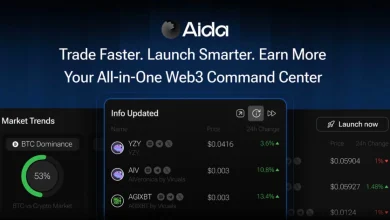
Leveraged trading is a potent tool for people who are experienced in reading financial markets. By increasing one’s exposure, a trader can achieve a higher profit, assuming the trade works out.
gTrade recently introduced the option to explore leveraged trading on the price of stocks in a decentralized environment.
The Concept of Leveraged Trading
People engaging in trading financial markets – stocks, currencies, indices, cryptocurrencies, or otherwise – will have the option to engage in leveraged trading.
Also known as margin trading, it enables a trader to open a position with a small amount of capital to take a much larger position in the market. For instance, with 10x leverage, one can invest $10 and obtain a $100 position.
The main appeal of leveraging a trade is increasing the returns per trade. If timed correctly and the market sentiment goes in the right direction, it can exponentially increase the profitability of a trade. However, if the trade is placed at the wrong time, it will exponentially increase one’s losses too.
Seeking high rewards comes with higher risks, and leveraged trading remains one of the riskiest approaches to any market.
Depending on the platform one uses, it may be possible to achieve leverage of up to 250x. That means increasing your position size by 25,000%, which can destroy a portfolio in seconds if things do not work out.
However, most platforms will maintain much lower limits to protect investors from digging a financial hole they might not be able to get themselves out of.
Thankfully, the majority of providers will let users manage their risk to avoid significant losses. Moreover, numerous providers let users experiment with leverage on cryptocurrencies, precious metals, and even stock prices.
Doing so in a decentralized manner ensures there can be no disputes and there are no hidden fees to worry about. The following platforms all provide leveraged trading functionality in various degrees.
gTrade
The gTrade decentralized trading platform offers a variety of ways to leverage investments. The platform supports cryptocurrencies, foreign exchange, and recently added leveraged trading for stock prices.
The platform notes over $12.6 billion in all-time volume and requires no signup. Traders flock to gTrade for its optimal trading experience at minimal transaction fees and high throughput.
More importantly, the decentralized platform sources price information from reliable sources rather than relying on generated or derivatives prices.
Additionally, users do not borrow capital for the leverage, and the synthetic trading architecture ensures orders have a 0% price impact. gTrade operates under the Gains Network banner, an innovative decentralized finance ecosystem of products on the Polygon layer-2 network.
Like traditional investing, leveraged trading requires a diversified approach. Putting all of one’s eggs in the same basket is never a smart approach, and gTrade lets users explore different markets and industries.
Their recent addition of leveraged trading for stock prices is intriguing, highlighting the potential of this decentralized platform. Moreover, it sets the platform apart from other decentralized providers.
dYdX
While dYdX is one of the oldest and most established platforms in the decentralized world, it primarily focuses on derivatives and margin trading, and staking pools.
More specifically, it has a rather limited set of trading options compared to gTrade, even though there is a loyal group of users who keep exploring new market opportunities across perpetuals and margins. Additionally, it has liquidity pools supporting flash transactions.
Like gTrade, dYdX mainly wants to offer non-custodial trading at low costs. It has partnered with StarkWare’s StarkEx, a Layer-2 scalability engine, to facilitate growth in that department. dYdX generated an average of $1.1 billion in daily trading volume across over 140,000 trades.
Injective Protocol
The Injective Protocol team envisioned a world in which a decentralized exchange would provide cross-chain margin trading, derivatives, and forex futures trading.
That vision has come true through building a Layer 2 application on the Cosmos ecosystem. Its native bridges enable access to assets on other chains, including Ethereum and Polkadot. Contrary to other decentralized exchanges, Injective uses an order book model instead of embracing the automated market maker approach.
Users benefit from no gas fees, although transactions are subject to maker and taker fees. Those costs are covered through INJ tokens, the native currency of this ecosystem.
Moreover, the team has introduced support for synthetic assets and futures trading to complement its existing suite of trading vehicles.
Conclusion
Margin or leveraged trading continues to attract much attention from builders and users alike. It is an excellent way of making big money quickly, although it incurs serious risks.
The decentralized approach to leveraged trading ensures users do not suffer from any unnecessary intermediaries taking a cut. Everything is transparent on the blockchain, and users interact with code directly.
Disclaimer and Risk Warning
The guest posts featured on Coinpedia are contributed by external authors and reflect their personal opinions and viewpoints. Coinpedia does not endorse, verify, or take responsibility for the accuracy, legality, or reliability of the content, advice, or opinions expressed in these guest posts. Including guest posts does not imply Coinpedia's approval of the content or the author’s views. Readers are encouraged to independently evaluate the information and seek professional advice if necessary before acting on any information provided in the guest posts.








